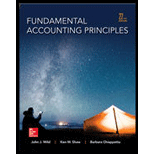
Concept explainers
Journals:
Journals are the books where all the original entries of business transactions are recorded on basis of its occurrence order and date.
Sales Journal:
The journal where all the credit sales of merchandise are recorded is called a Sales Journal.
Cash Receipts Journal:
Cash receipts journal records all type cash receipts of a business organization like cash sales, collections from debtors, loans and borrowings etc.
A subsidiary ledger of accounts receivable shows the amount of money paid and owed by debtors for the transactions made on credit individually.
Schedule of Accounts Receivable:
A schedule of accounts receivable represents the overall amount of money owed by the debtors for credit transactions during a specified period.
To determine:
1. Preparation of sales journal and cash receipts journal. Journalize the transactions that should be recorded in the sales journal and cash receipts journal.
2. Prepare the general ledger accounts and accounts receivable subsidiary ledger accounts.
3. Verify the amounts that should be posted as individual amounts from the journals have been posted. Foot and crossfoot the journals and make the month-end postings.
4. Preparation of
Want to see the full answer?
Check out a sample textbook solution
Chapter 7 Solutions
Fundamental Accounting Principles -Hardcover
- Provide answerarrow_forwardPlease provide correct solution and accounting questionarrow_forwardBradford Enterprises sells two products, blue pens and green notebooks. Bradford predicts that it will sell 3,200 blue pens and 900 green notebooks in the next period. The unit contribution margins for blue pens and green notebooks are $2.80 and $4.20, respectively. What is the weighted average unit contribution margin?arrow_forward

 AccountingAccountingISBN:9781337272094Author:WARREN, Carl S., Reeve, James M., Duchac, Jonathan E.Publisher:Cengage Learning,
AccountingAccountingISBN:9781337272094Author:WARREN, Carl S., Reeve, James M., Duchac, Jonathan E.Publisher:Cengage Learning, Accounting Information SystemsAccountingISBN:9781337619202Author:Hall, James A.Publisher:Cengage Learning,
Accounting Information SystemsAccountingISBN:9781337619202Author:Hall, James A.Publisher:Cengage Learning, Horngren's Cost Accounting: A Managerial Emphasis...AccountingISBN:9780134475585Author:Srikant M. Datar, Madhav V. RajanPublisher:PEARSON
Horngren's Cost Accounting: A Managerial Emphasis...AccountingISBN:9780134475585Author:Srikant M. Datar, Madhav V. RajanPublisher:PEARSON Intermediate AccountingAccountingISBN:9781259722660Author:J. David Spiceland, Mark W. Nelson, Wayne M ThomasPublisher:McGraw-Hill Education
Intermediate AccountingAccountingISBN:9781259722660Author:J. David Spiceland, Mark W. Nelson, Wayne M ThomasPublisher:McGraw-Hill Education Financial and Managerial AccountingAccountingISBN:9781259726705Author:John J Wild, Ken W. Shaw, Barbara Chiappetta Fundamental Accounting PrinciplesPublisher:McGraw-Hill Education
Financial and Managerial AccountingAccountingISBN:9781259726705Author:John J Wild, Ken W. Shaw, Barbara Chiappetta Fundamental Accounting PrinciplesPublisher:McGraw-Hill Education





